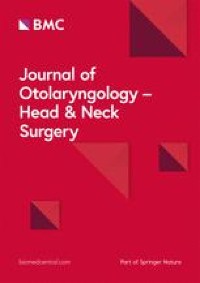|
Αρχειοθήκη ιστολογίου
-
►
2023
(391)
- ► Φεβρουαρίου (200)
- ► Ιανουαρίου (191)
-
▼
2022
(2843)
- ► Δεκεμβρίου (161)
- ► Σεπτεμβρίου (219)
-
▼
Μαρτίου
(314)
-
▼
Μαρ 22
(10)
- Pepsinogen/Proton Pump Co‐Expression in Barrett's ...
- ROBOTIC REPAIR OF ATRIAL SEPTAL DEFECT WITH PARTIA...
- The effectiveness of topical 1% lidocaine with sys...
- Comparison of Video Head Impulse Test Findings in ...
- Pinna injuries management at tertiary care center
- The outcome of tympanic membrane grafting medial o...
- Otogenic Cerebral Venous Sinus Thrombosis: A Case ...
- The Endonasal Endoscopic Approach to Different Sin...
- Injection laryngoplasty during transoral laser mic...
- Evolution of midface microvascular reconstruction:...
-
▼
Μαρ 22
(10)
- ► Φεβρουαρίου (264)
- ► Ιανουαρίου (280)
-
►
2021
(5625)
- ► Δεκεμβρίου (231)
- ► Σεπτεμβρίου (345)
- ► Φεβρουαρίου (620)
-
►
2020
(2065)
- ► Δεκεμβρίου (535)
- ► Σεπτεμβρίου (222)
- ► Φεβρουαρίου (28)
-
►
2019
(9608)
- ► Δεκεμβρίου (19)
- ► Σεπτεμβρίου (54)
- ► Φεβρουαρίου (3791)
- ► Ιανουαρίου (3737)
-
►
2018
(69720)
- ► Δεκεμβρίου (3507)
- ► Σεπτεμβρίου (3851)
- ► Φεβρουαρίου (8116)
- ► Ιανουαρίου (7758)
-
►
2017
(111579)
- ► Δεκεμβρίου (7718)
- ► Σεπτεμβρίου (7549)
- ► Φεβρουαρίου (10753)
- ► Ιανουαρίου (10529)
-
►
2016
(16402)
- ► Δεκεμβρίου (7478)
- ► Φεβρουαρίου (900)
- ► Ιανουαρίου (1250)
! # Ola via Alexandros G.Sfakianakis on Inoreader
Η λίστα ιστολογίων μου
Τρίτη 22 Μαρτίου 2022
Pepsinogen/Proton Pump Co‐Expression in Barrett's Esophageal Cells Induces Cancer‐Associated Changes
ROBOTIC REPAIR OF ATRIAL SEPTAL DEFECT WITH PARTIAL PULMONARY VENOUS RETURN ANOMALY: OUR 5‐YEAR EXPERIENCE
|
The effectiveness of topical 1% lidocaine with systemic oral analgesics for ear pain with acute otitis media
|
Comparison of Video Head Impulse Test Findings in Individuals Aged between 20–39 and 40–60 Years
|
Pinna injuries management at tertiary care center
|
The outcome of tympanic membrane grafting medial or lateral to malleus handle in type I underlay tympanoplasty
|
Otogenic Cerebral Venous Sinus Thrombosis: A Case Report and Literature Review
|
The Endonasal Endoscopic Approach to Different Sinonasal Fungal Balls
|
Injection laryngoplasty during transoral laser microsurgery for early glottic cancer: a randomized controlled trial
|
Evolution of midface microvascular reconstruction: three decades of experience from a single institution
|
Αρχειοθήκη ιστολογίου
-
►
2023
(391)
- ► Φεβρουαρίου (200)
- ► Ιανουαρίου (191)
-
▼
2022
(2843)
- ► Δεκεμβρίου (161)
- ► Σεπτεμβρίου (219)
-
▼
Μαρτίου
(314)
-
▼
Μαρ 22
(10)
- Pepsinogen/Proton Pump Co‐Expression in Barrett's ...
- ROBOTIC REPAIR OF ATRIAL SEPTAL DEFECT WITH PARTIA...
- The effectiveness of topical 1% lidocaine with sys...
- Comparison of Video Head Impulse Test Findings in ...
- Pinna injuries management at tertiary care center
- The outcome of tympanic membrane grafting medial o...
- Otogenic Cerebral Venous Sinus Thrombosis: A Case ...
- The Endonasal Endoscopic Approach to Different Sin...
- Injection laryngoplasty during transoral laser mic...
- Evolution of midface microvascular reconstruction:...
-
▼
Μαρ 22
(10)
- ► Φεβρουαρίου (264)
- ► Ιανουαρίου (280)
-
►
2021
(5625)
- ► Δεκεμβρίου (231)
- ► Σεπτεμβρίου (345)
- ► Φεβρουαρίου (620)
-
►
2020
(2065)
- ► Δεκεμβρίου (535)
- ► Σεπτεμβρίου (222)
- ► Φεβρουαρίου (28)
-
►
2019
(9608)
- ► Δεκεμβρίου (19)
- ► Σεπτεμβρίου (54)
- ► Φεβρουαρίου (3791)
- ► Ιανουαρίου (3737)
-
►
2018
(69720)
- ► Δεκεμβρίου (3507)
- ► Σεπτεμβρίου (3851)
- ► Φεβρουαρίου (8116)
- ► Ιανουαρίου (7758)
-
►
2017
(111579)
- ► Δεκεμβρίου (7718)
- ► Σεπτεμβρίου (7549)
- ► Φεβρουαρίου (10753)
- ► Ιανουαρίου (10529)
-
►
2016
(16402)
- ► Δεκεμβρίου (7478)
- ► Φεβρουαρίου (900)
- ► Ιανουαρίου (1250)





